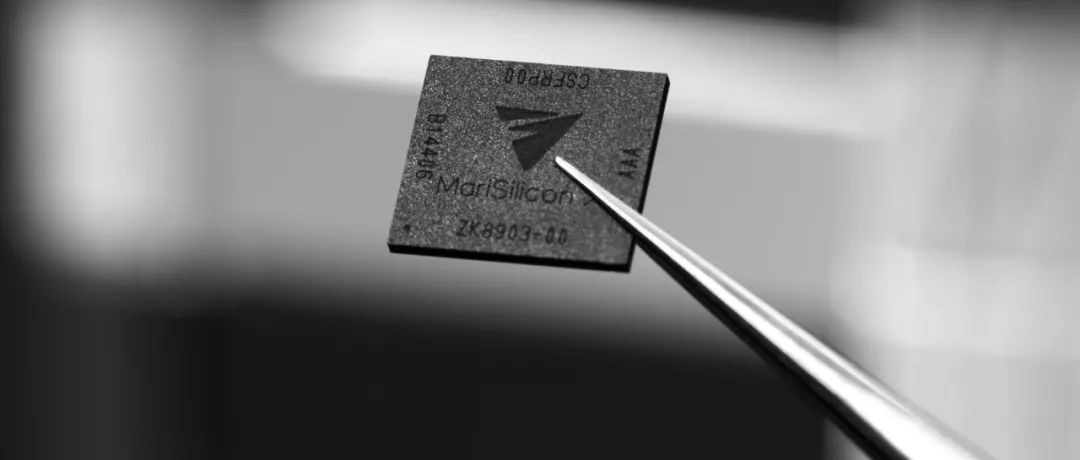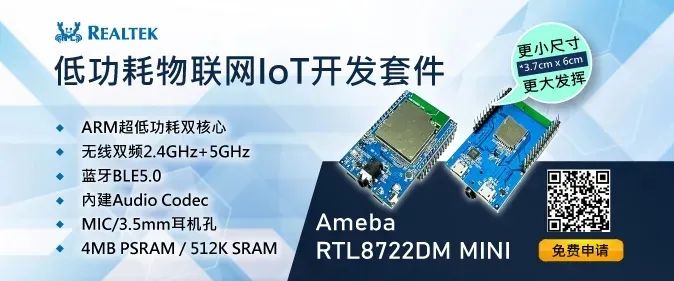The Internet of Things (IoT) was still a very vague concept a decade ago. With the development of technology across various industries over the past ten years, and the deepening commercialization of 5G, the mainstream communication infrastructure representing the next decade, the initial slogan of “connecting everything” has gradually become clearer. The competition among IoT operating systems (OS) has also begun to intensify.
Domestic and International IoT OS
According to statistics, there are dozens of IoT OS both domestically and internationally.
Internationally, there are the earliest VxWorks (1983), Ubuntu Core, RIOT, Contiki, Mbed OS, RTX, TinyOS, FreeRTOS, Windows IoT, ThreadX, Google’s “Fuchsia,” Zephyr, Micrium-μC/OS-II, embedded Linux, BlackBerry QNX, Siemens EDA’s Nucleus, Samsung Tizen RT, and so on.
Domestically, there are Huawei’s LiteOS and HarmonyOS, Alibaba’s AliOS Things, Tencent’s TencentOS tiny, RT-Thread, China Mobile’s OneOS, Mxchip’s MiCO jointly released with Alibaba Cloud, SylixOS developed by Yihui Information, and various OS launched by companies like Haier and the Aviation Computing Institute.
Although OS was mostly monopolized by foreign companies a few years ago, the most well-known and widely used today are HarmonyOS and RT-Thread (RTT).
Huawei HarmonyOS is a commercial OS customized based on the OpenHarmony OS donated to the OpenAtom Foundation, while RT-Thread is an IoT operating system that RuiSaiDe Technology insists on being open-source and claims to be “small and beautiful.”
Despite facing sanctions from the United States, Huawei’s size and strength remain significant, and HarmonyOS continues to develop as planned, surpassing 100 million users by September 2021. HarmonyOS has now evolved to version 2.0.1, with version 3.0 expected to be released in Q1 2022. HarmonyOS is no longer limited to IoT but has expanded into smartphones, wearable devices, and in-vehicle systems. The five major divisions established by Huawei are also based on HarmonyOS. Currently, HarmonyOS can be described as large and comprehensive.
For more information about HarmonyOS, you can follow us or the author (same name on WeChat), or search for more information on the website.
Regarding RT-Thread, according to the latest data released at the 2021 RT-Thread Developer Conference, its installed base has exceeded 1.4 billion, with tens of thousands of enterprise users and support from over 100 domestic and international chip manufacturers. RT-Thread Studio tools have over 150,000 users.
Although their target user groups differ, they are roughly equivalent in scale.
Next, we will extend our analysis by comparing and contrasting their business models, ecological closed loops, and applications in mainstream IoT fields such as automotive, wearables, and aerospace defense.
1. Business Model
HarmonyOS is developed and customized by Huawei based on OpenHarmony, most of which has been contributed by Huawei, with the core contributions still primarily from Huawei. OpenHarmony serves as the foundation for “HarmonyOS.”
Currently, Midea has developed its own “Midea IoT Operating System 1.0” based on OpenHarmony 2.0, and Haoba Technology has released the first domestic lightweight HarmonyOS smartwatch OS distribution based on OpenHarmony.
The main force behind OpenHarmony is still Huawei HarmonyOS.
RuiSaiDe Technology enjoys a good reputation in the domestic OS field, as a contributor and maintainer of the RT-Thread open-source IoT operating system, responsible for core technology development, community operations, and market promotion. Almost all manufacturers use RT-Thread for custom development and support for underlying interfaces. Of course, RuiSaiDe Technology has also developed several commercialized OS based on industry needs.
Thus, RuiSaiDe Technology mainly commercializes through value-added software, custom development, and technical services, which is currently its primary profit model (or business model). Meanwhile, the RT-Thread IoT operating system itself will continue to remain open-source.
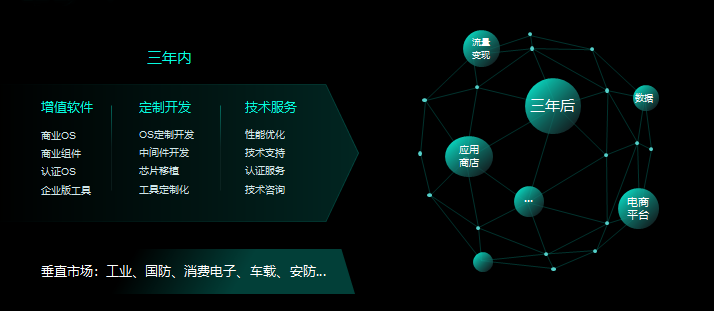
RT-Thread model definition, profit model ▲
Therefore, the business models of the two have some differences:
Huawei primarily focuses on HarmonyOS while contributing source code and solutions to the underlying OpenHarmony;
RuiSaiDe Technology will continue to contribute and maintain RT-Thread while leveraging its strong R&D capabilities to promote the development of commercialized OS for specific fields.
2. Ecological Closed Loop
The core of an OS’s ecology mainly lies in the support of hardware and software at the bottom level and the degree of involvement from various manufacturers. This expands to include operations, talent, technology, funding, etc.
The ecology of Huawei HarmonyOS is currently led by Huawei. Whether it is the developer conference or support for various hardware and software at the bottom level, Huawei is promoting the development of HarmonyOS across various industries. In terms of funding, Huawei is the sole investor. Currently, other distributions based on OpenHarmony (such as those mentioned above from Midea and Haoba Technology) are independently funded by other entities for research and application.
RT-Thread is completely open-source and has formed a mature ecosystem driven by the RT-Thread community, with many developers actively contributing source code to the open-source RT-Thread, and manufacturers also actively providing bottom-level support for RT-Thread. Of course, RuiSaiDe Technology is also a major contributor to the overall framework and most of the source code, but the level of external participation is far greater than that of HarmonyOS.
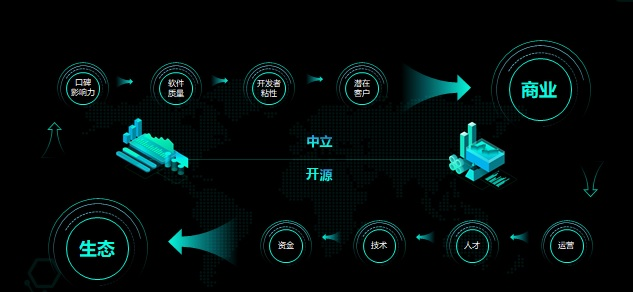
RT-Thread ecology ▲
In the RT-Thread ecosystem, there are currently nearly 400 software packages, many of which have been contributed by community members. The total download volume of the software packages has reached approximately 7 million. The number of contributors to RT-Thread has approached 1,000, and over 150 universities nationwide have established cooperative courses or laboratories, with one university overseas using RT-Thread for courses. Domestic and foreign chip manufacturers recognize RT-Thread, with more than 10 paid members.
3. Industry Development
Currently, the main fields of IoT in the technology industry are: the automotive sector represented by new car-making forces, wearable devices that may gradually replace smartphones as the next generation of smart terminals, and industrial and aerospace fields. These areas have high requirements and demands for IoT OS. This article mainly analyzes the development of HarmonyOS and RuiSaiDe Technology in these three major fields.
1. Automotive Sector: Autonomous Driving and In-Vehicle Market
Huawei HarmonyOS has already launched the autonomous driving car, the Extreme Fox Alpha S, in collaboration with Extreme Fox in April 2021, which is expected to be launched by the end of this year.
At the same time, reports indicate that Huawei showcased its HarmonyOS smart cockpit in December. By the end of this year or early next year, the new luxury mid-size SUV released by Xiaokang Silis will be equipped with a smart cockpit based on HarmonyOS. Huawei aims to provide a user experience for smart cockpits that surpasses other manufacturers globally. Additionally, based on the HarmonyOS in-vehicle system, Huawei has established deep cooperation with over 80 hardware and software partners.
At the RT-Thread Developer Conference on December 18, RuiSaiDe Technology also announced its in-vehicle integrated system.
According to Mr. Xiong Pu-xiang, founder of RT-Thread and CEO of RuiSaiDe Technology, several car manufacturers are collaborating to develop an in-vehicle OS based on RT-Thread, focusing on reliability, real-time performance, and high security, which is expected to be released in 2022.
In the automotive sector, HarmonyOS mainly focuses on complete machine cooperation and smart cockpit creation, aiming for the “large” approach, while RT-Thread emphasizes building the underlying OS and collaborating with industry manufacturers.
2. Wearable Devices
Wearable devices are expected to gradually replace smartphones in the next 5-10 years, becoming one of the core devices of the next generation of smart terminals. Among wearable devices, smartwatches best meet consumer usage habits and needs. The market growth of smartwatches reached about 10% in 2021, with future growth expected to be faster, especially for smartwatches.
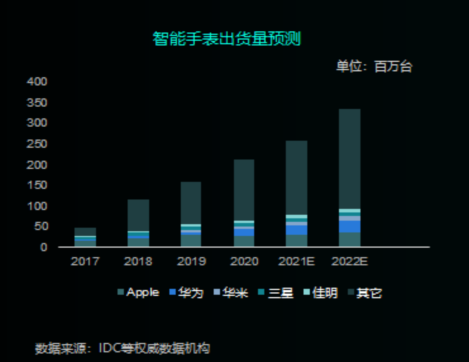
In this regard, Huawei launched the GT series of smartwatches in 2019, all upgraded to HarmonyOS this year (2021), aiming to create a future-oriented potential wearable device market. In 2020, Huawei’s smart wearable device shipments ranked first, but due to sanctions from the United States, its market share had dropped to fourth by the end of 2021, according to IDC statistics.
RT-Thread also launched the PersimWear platform for smart wearables in 2019, which will go live on the application store and smartwatch mall by the end of December.
According to Mr. Zou Cheng, Chief Operating Officer of RuiSaiDe Technology, over 10 manufacturers are currently using the PersimWear platform, with most manufacturers located in Shenzhen, including first-tier and second-tier brands, and the largest manufacturer in Shenzhen, reportedly including vivo.
This indicates that the PersimWear platform based on RT-Thread may experience a market explosion similar to Android smartphones in the future.
3. Industrial, Aerospace, and Defense
In late October, Huawei established five major divisions for coal mines, smart highways, customs and ports, smart photovoltaics, and data center energy, all based on HarmonyOS as the technical foundation, which is considered a major source of revenue.
RuiSaiDe Technology also launched RT-Thread Secure for large industries: a high-reliability, high-performance, and easy-to-develop software platform for industrial automation, defense, rail transit, and electric power industries.
Additionally, they launched RT-Thread Space for the aerospace field.
RT-Thread Space is a minimalist operating system kernel designed for aerospace. The operating systems on rockets, satellites, and aircraft do not require overly complex functions. The characteristics of aerospace OS are primarily to achieve the same functionality with the simplest code, with a kernel of no more than 5,000 lines of code. Secondly, it must have extreme determinism, including time and space determinism, achieving microsecond-level response. Thirdly, it must have high reliability, meeting the requirements of national military standards.
According to Mr. Zou Cheng, some partners of RuiSaiDe Technology have successfully launched a rocket and a satellite based on the RT-Thread Space system, and everything went exceptionally well, with clients giving high praise for this system and service.
“In the aerospace system, there will be more and more unified platforms in the future. We hope that all chips and devices can run on the Space system, which can help developers improve development efficiency and launch more aerospace equipment, realizing the dream of a strong aerospace nation,” Mr. Zou stated.
Conclusion
Since 2019, I have been analyzing and comparing the development of HarmonyOS and RT-Thread every year. Now, three years have passed, and both have made significant progress.
In terms of open-source and openness, although OpenHarmony is open-source and open, HarmonyOS is actually in a semi-open-source and semi-open state, while RT-Thread has always adhered to open-source and openness. RuiSaiDe Technology has also found a balance between open-source and commercialization, ensuring open-source while providing valuable support and services to clients.
Therefore, the future development trajectories of the two may evolve from their initial intersections to parallel paths.
HarmonyOS has transitioned from primarily targeting IoT OS to now being large and comprehensive across various industries, while RT-Thread has consistently maintained its position as a “small and beautiful” IoT OS. The strengths behind both currently differ significantly, but the efforts and achievements in their respective OS investments are not vastly different (HarmonyOS has over 100 million users, primarily consumers, while RT-Thread has over 1.4 billion installations, mainly collaborators).
Huawei HarmonyOS is immeasurable, while RT-Thread, with its mature underlying ecosystem, should not be underestimated.
Whether “large and comprehensive” or “small and beautiful,” the models should be determined based on the actual conditions of their respective supporting entities.
As two major IoT OS developed independently in China and both having gone global, Harmony/OpenHarmony boasts an excellent industrial architecture, while RT-Thread has a high-quality underlying ecosystem. We look forward to both sides intersecting again in the future, bringing better experiences and stronger open-source systems to the industry, truly achieving the interconnection of all things.
Editor: Amy Wu
Popular Articles:
Top 10 Animated Diagrams: Understand Various Common Communication Protocols
2021-12-19
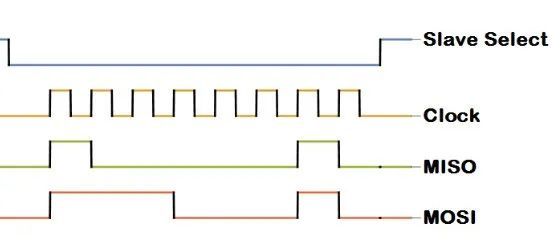
ARM Instruction Assembly, Please Save!
2021-12-19

Understand Typical Application Circuits of Microphones in One Article
2021-12-18

Polarity Correction Circuit to Protect Battery-Powered Devices
2021-12-17

Why Does OPPO Self-Develop NPU? The Reason Is Too Realistic
2021-12-15
